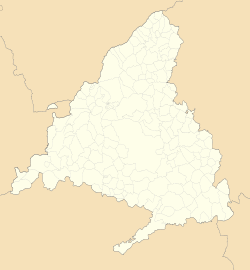
Murcia is a city in south-eastern Spain, the capital and most populous city of the autonomous community of the Region of Murcia, and the seventh largest city in the country. It has a population of 460,349 inhabitants in 2021. The total population of the metropolitan area is 672,773 in 2020, covering an urban area of 1,230.9 km2. It is located on the Segura River, in the southeast of the Iberian Peninsula. It has a climate with hot summers, mild winters, and relatively low precipitation.
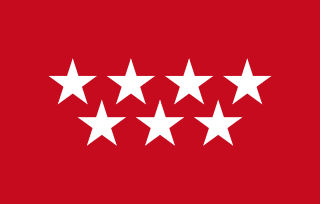
The Community of Madrid is one of the seventeen autonomous communities of Spain. It is located in the centre of the Iberian Peninsula, and of the Central Plateau . Its capital and largest municipality is the City of Madrid, which is also the capital of the country. The Community of Madrid is bounded to the south and east by Castilla–La Mancha and to the north and west by Castile and León. It was formally created in 1983, based on the limits of the province of Madrid, which was until then conventionally included in the historical region of New Castile.
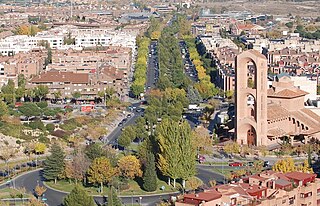
Pozuelo de Alarcón is a municipality in the Community of Madrid, Spain. Bordering the Moncloa-Aravaca district of Madrid proper to its west, Pozuelo de Alarcón is surrounded by large Mediterranean pine-tree forests: the Casa de Campo, the Monte del Pardo, and the Monte del Pilar. As of 2022, it ranks as the wealthiest municipality in Spain. La Finca, an isolated luxury residential area known by its affluent residents, most notably football players, lies within the municipality bounds.
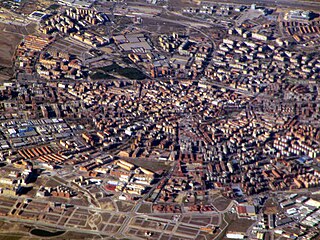
Móstoles is a municipality of Spain located in the Community of Madrid. With over 200,000 inhabitants, it is the region's second most populated municipality after Madrid. Móstoles was a small town for a long time, but expanded rapidly in the second half of the 20th century.

Getafe is a municipality and a city in Spain belonging to the Community of Madrid. As of 2018, it has a population of 180,747, the region's sixth most populated municipality.
Pinto is a municipality in the Community of Madrid, Spain. It is located in the central area of the Iberian Peninsula at an altitude of 604 meters, 20 kilometers south of Madrid, and covers 62.7 square kilometers. In 2018, Pinto had a population of 51,541. It is home to the Torre de Pinto, the Pinto Castle, and the Éboli Tower, which is a 14th-century tower used as a prison for nobles who fell out of favor with the king.
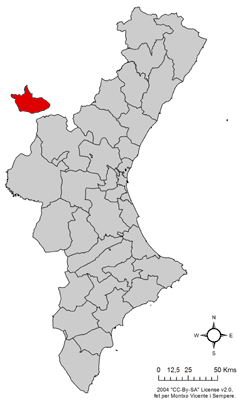
Rincón de Ademuz is a Spanish comarca constituted as an exclave of both the Valencian Community and the Valencia province located between the provinces of Cuenca and Teruel (Aragon). It is part of the Spanish-speaking area in the Valencian Community.

Villanueva de la Cañada is a municipality in the Community of Madrid, Spain. Located 30 km north-west from Madrid, the municipality covers an area of 34.92 km2. Geographically, it sits on a large plain, in which there are several promontories, on one of which is found the castle of Aulencia, its main landmark. The ESA's European Space Astronomy Centre lies close to the former, on the Guadarrama riverfront. Villafranca del Castillo, a well-off urban area detached from the main nucleus, is located within the municipal bounds. Villanueva de la Cañada hosts the main campus of the Alfonso X El Sabio University as well as the Aquópolis waterpark.

Colmenar Viejo is a town and municipality of about 48,614 inhabitants, located in the Community of Madrid, Spain, 30 kilometers north of Madrid on the M-607 motorway. It belongs to the comarca of Cuenca Alta del Manzanares.
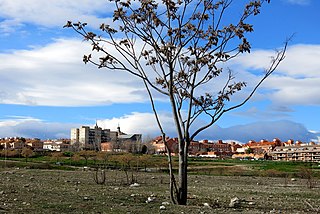
Ciempozuelos is a municipality in Spain located in the Community of Madrid. The municipality spans across a total area of 49.64 km2 and, as of 1 January 2020, it has a registered population of 25,104.

El Casar is a municipality located in the province of Guadalajara, Castile-La Mancha, Spain.

Ambite is a municipality in the province of Madrid in central Spain. It belongs to the comarca of Alcalá. It has 382 inhabitants in an area of 26 square kilometres (10 sq mi), with a population density of 14.69 hab/km2. It lies 770 metres (2,530 ft) above sea level.

Tizapán El Alto is a town and municipality, in Jalisco in central-western Mexico. The municipality covers an area of 105.53 square miles.

Corpa is a municipality of the autonomous community of Madrid in central Spain. It belongs to the comarca of Alcalá.

Campo de Cartagena, is a natural region (comarca) located in the Region of Murcia, in Spain. For administrative purposes, it is also known, as Comarca del Campo de Cartagena or Comarca de Cartagena. It is located in the southeast of the Iberian Peninsula, forming a plain which extends from the Sierra de Carrascoy to the Mediterranean. The capital city is Cartagena, the most important Naval Base of the Spanish Navy in the Mediterranean Sea.

Purabá is a district of the Santa Bárbara canton, in the Heredia province of Costa Rica. The district consists of several large neighborhoods: San Bosco (Bosconia), Marías, Purabá, Lajas, and Calle Quirós.

The 2007 Madrid City Council election, also the 2007 Madrid municipal election, was held on Sunday, 27 May 2007, to elect the 8th City Council of the municipality of Madrid. All 57 seats in the City Council were up for election. The election was held simultaneously with regional elections in thirteen autonomous communities and local elections all throughout Spain.

The 2019 Madrid City Council election, also the 2019 Madrid municipal election, was held on Sunday, 26 May 2019, to elect the 11th City Council of the municipality of Madrid. All 57 seats in the City Council were up for election. The election was held simultaneously with regional elections in twelve autonomous communities and local elections all throughout Spain, as well as the 2019 European Parliament election.
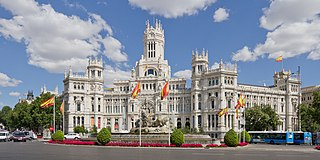
The City Council of Madrid is the top-tier administrative and governing body of the Madrid, the capital and biggest city of Spain.

Somosierra is a municipality in the Community of Madrid, Spain, located at 83 km north of Madrid, in the mountain pass with the same name, at an elevation of 1433 metres above sea level, being the northernmost town of Community of Madrid. The Battle of Somosierra was fought here in 1808 during the Napoleonic Wars, and the Battle of Guadarrama was fought nearby in 1936 during the Spanish Civil War.


